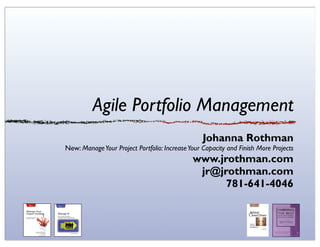
Agile portfolio planning
- 1. Agile Portfolio Management Johanna Rothman New: Manage Your Project Portfolio: Increase Your Capacity and Finish More Projects www.jrothman.com jr@jrothman.com 781-641-4046
- 2. How Many of You Like Multitasking Among Several Projects? 2 © 2011 Johanna Rothman
- 3. What Are You Supposed to Do First? 3 © 2011 Johanna Rothman
- 4. 4 © 2011 Johanna Rothman
- 5. What’s the Problem? Too many simultaneous projects Too much interrupting work Technical work and multitasking is invisible 5 © 2011 Johanna Rothman
- 6. What Some Project Portfolios Look Like 6 © 2011 Johanna Rothman
- 7. What These Portfolios Are Missing 7 © 2011 Johanna Rothman
- 8. Combination View: Low and Mid Level 8 © 2011 Johanna Rothman
- 9. What is the Project Portfolio? Organization of all the projects (and all the work) the organization is attempting to manage When they start When they end Which one is #1 Decide when projects are done--or done enough Decide when to stop, kill, or cancel projects 9 © 2011 Johanna Rothman
- 10. So What? The portfolio of work-in-progress tells you what is happening and when you can change it Similar to a product backlog Requires cross-organizational commitment 10 © 2011 Johanna Rothman
- 11. Use the Portfolio to Make Decisions,Tradeoffs, and Assignments Move between the strategic view to the tactical view Create a rolling wave plan Provide transparency into the organization’s work 11 © 2011 Johanna Rothman
- 12. Consider Lean Iterate on value, redefining it over and over... You have more choices if you can see demos as the projects proceed If you can see the work in progress, you can manage it 12 © 2011 Johanna Rothman
- 13. Project Portfolio Flow 13 © 2011 Johanna Rothman
- 14. When to Make Decisions When some feature or iteration finishes--project cycles Concept of a MMF, Minimum Marketable Feature When you have enough information about the next version of a product--planning cycles When it's time to allocate budget and people to a new project--business cycles 14 © 2011 Johanna Rothman
- 15. How to Make Decisions Qualitative questions Quantitative questions Only do work that’s currently valuable 15 © 2011 Johanna Rothman
- 16. Qualitative Questions Should we do this project at all? How does this project fit in with all the others? What is the strategic reason for this project? Is there a tactical gain from completing this project? To make this project successful, are we ready to adequately fund it? To make this project successful, are we ready to adequately staff it? Do we know what success looks like for this project? Is there waste associated with the lack of this project? 16 © 2011 Johanna Rothman
- 17. Quantitative Questions When will we see any monetary return from this project? What's the expected revenue curve for this project? What's the expected customer acquisition curve for this project? When will we see retention of current customers from this project? What's the expected customer growth curve? When will we see reduction in operating costs from this project? What's the expected operating cost curve? How will this project move the organization forward? 17 © 2011 Johanna Rothman
- 18. Doing Work that’s Currently Valuable Rank the products Rank the features for a product Requires market knowledge to know when the team has done enough 18 © 2011 Johanna Rothman
- 19. Three Kinds of Projects Projects that keep the lights on--that support the organization Projects that grow the business Projects that create new opportunities 19 © 2011 Johanna Rothman
- 20. Why Manage the Project Portfolio? People can only work on one project at a time Project portfolio makes it clear where the time is being allocated—and where the time is not allocated Makes it possible for the organization to optimize at the organization level, not at the person level Staff the most important work Not staff the least important work 20 © 2011 Johanna Rothman
- 21. Why Does Agile/Lean Work? Agile helps: Finishing running, tested features Have release-able product periodically (every timebox) Lean helps Creating a culture of not having a lot of work in process Instead, finish things and move on to the next one 21 © 2011 Johanna Rothman
- 22. 100% Utilization is for Machines 22 © 2011 Johanna Rothman
- 23. It doesn’t matter how many projects you start. What does matter is how many projects you finish. And when. 23 © 2011 Johanna Rothman
- 24. References and Resources Manage Your Project Portfolio: Increase Your Capacity and Finish More Projects, Pragmatic Bookshelf, 2009. Tons more on jrothman.com If you want to me to stay in touch with you, give me your card or fill out a yellow form to sign up for my email newsletter, The Pragmatic Manager, jrothman.com/ pragmaticmanager/ 24 © 2011 Johanna Rothman
